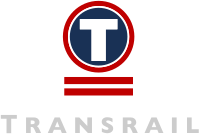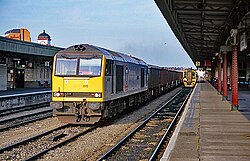Transrail Freight
 | |
 60015 Bow Fell with Transrail branding, Cardiff, 1996 | |
| Industry | Rail freight |
|---|---|
| Founded | 9 June 1994 as Trainload Freight West |
| Defunct | 1996 |
| Fate | Acquired by Wisconsin Central Ltd. |
| Successor | English Welsh & Scottish |
| Headquarters | , |
| Services | Freight train owner/operator |
| Parent | British Rail |
Transrail was a trainload rail freight operator based in St Blazey, England, UK with a large operating area including Scotland, Wales and the west of England. It was formed in 1994 from part of British Rail's Trainload Freight division, as part of the privatisation of British Rail.
Mainline Freight, Loadhaul and Transrail were purchased by a consortium led by Wisconsin Central in 1996 and amalgamated into a new company, English Welsh & Scottish.
History[edit]
Transrail was created in 1994 along with Mainline Freight and Loadhaul as part of the broadly regional split of British Rail's Trainload Freight operations. Transrail had the largest operating area of the three companies, operating in Scotland, Wales and the entire west of England (South West, West Midlands, and North West). The three companies were created with the aim of promoting competition between the businesses.[1][2] It was initially and briefly named "Trainload Freight West Limited" before being re-branded in July 1994.[3]
Transrail had the largest inherited operating area of the three post-Trainload Freight companies, but the least amount of traffic. The company initiated a long-distance wagonload train service branded 'Enterprise',[4] later operated by EWS as the 'EWS Enterprise' service.[5][6][full citation needed]
All three former Trainload Freight companies were acquired in February 1996 by North-South Railways, a company formed by a consortium led by US railroad company Wisconsin Central, for a combined total of £225.15 million (approximately US$349 million). The three companies and Rail Express Systems were merged to form English Welsh & Scottish (EWS).[1][2][7][8]
Fleet[edit]

Locomotives operated included classes 08, 31, 37, 47, 56 and 60.[9]
Livery[edit]
The company's livery was based on the previous Trainload Freight two-tone grey livery, with the addition of a blue and red "T" logo and Transrail branding.[9] There were also a few Class 37's and Class 56's that carried the blue and red "T" logo with Transrail branding on the Civil Engineers Yellow and Grey "Dutch" livery.
References[edit]
- ^ a b Nash, C.; Fowkes, T. (2004), "Rail Privatisation in Britain – Lessons for the rail freight industry : 2. The privatisation process", in European Conference of Ministers of Transport. Economic Research Centre (ed.), Report of the 125th Round Table on Transport Economics, Paris 28th–29th November 2002: European Integration of Rail Freight Transport, OECD Publishing, pp.61–95; C. Trainload, p.70; C1 EWS, pp.70–1, ISBN 9789282113196
- ^ a b Philippe Thalmann (2004), The dynamics of freight transport development: a UK and Swiss comparison, Ashgate Publishing, The Privatisation of the Freight Business, p.34–35, ISBN 9780754637561
- ^ WebCHeck - Select and Access Company Information, Companies House, see entries for TRANSRAIL FREIGHT LIMITED
- ^ "Transrail Freight", Railfan & Railroad, 15, Carstens Publications: 44, 1996
- ^ "Best practice must cross the frontiers", www.railwaygazette.com, Railway Gazette International, 1 February 1997
- ^ "The EWS story". The Railway Magazine. 2006. pp. 17–23.
- ^ "Rail Privatisation". Parliamentary Debates (Hansard). Hansard, House of Commons, UK. 27 December 1996. volume 296, 275W.
- ^ "WC group buys British freight services - Wisconsin Central buys Loadhaul, Transrail and Mainline Freight", Railway Age, Simmons-Boardman Publishing Corporation, March 1996
- ^ a b Shannon 2012, p. 13.
Bibliography[edit]
- Shannon, Paul (2012). EWS From Privatisation to DB. Ian Allan Publishing. ISBN 9780711035201.
External links[edit]
